In addition to cosmetic applications, many of which are considered off-label (see below), Botox is also FDA-approved for hyperhidrosis (excessive sweating). Xeomin is approved to treat abnormal spasms of the eyelids (blepharospasm) in adults who have had prior treatment with Botox. Xeomin is considered a more purified version of botulinum toxin type A than Botox because it does not have any protein additives. Some say this may help lower the risk of allergy to the product, as they believe the allergy risk is associated with these proteins. Xeomin is also the first denervating agent that does not need to be refrigerated before use.
Denervating agents have played a major part in the age of injectables, and doctors continue to find new and novel uses for them, as well as innovative ways to use them in conjunction with fillers.
- Eliminating wrinkles and lines caused by movement
- Excessive sweating (hyperhidrosis)
- Creating wider-looking eyes *
- Fixing scars *
- Reducing pore size *
- Lifting the top of the nose *
- Lessening a gummy smile *
- Treating migraines and TMJ *
- Eliminating neck bands and cleavage wrinkles *
- Temporarily improving the appearance of frown lines and crow’s-feet
- Treating chronic migraines, defined as 15 or more headache days a month, each lasting 4 or more hours
- Botox Cosmetic
- Xeomin
Although the overall experience is the same as with Botox and Xeomin, the main difference is that Dysport kicks in quicker—the results can usually be seen in a day or two, whereas Botox and Xeomin typically take three to five days. The results of both are believed to last about the same amount of time: on average, three months. However, after a series of injections, Dysport may last up to six months.
Please call The Paragon Plastic Surgery and Med Spa for more information on Botox and Xeomin at (817) 473-2120







